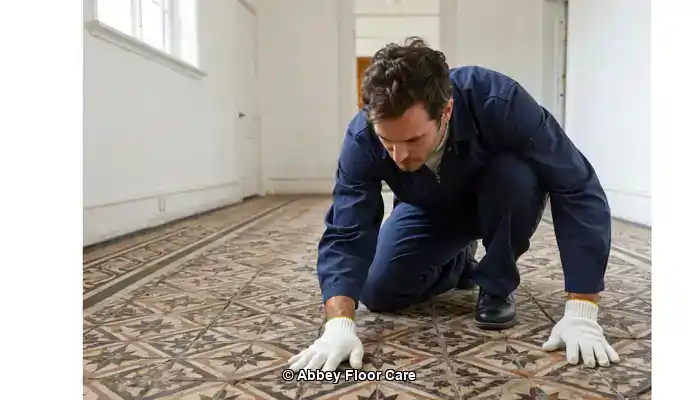
Last Updated on October 30, 2025 by David
Effective Strategies for Reviving the Original Colour and Pigment of Faded Victorian Mosaic Tiles
- Victorian mosaic tiles often lose their colour due to a combination of embedded dirt, aging coatings, and surface wear, rather than simply from the passage of time. This deterioration can significantly detract from their aesthetic appeal.
- Aggressive scrubbing and harsh chemicals can strip away the original pigments, which is particularly detrimental to encaustic and geometric tile designs that rely on their authentic coloration.
- Safe restoration starts with a meticulous cleaning process that employs pH-neutral solutions and low-speed rotary machines equipped with soft brushes to ensure gentle yet effective cleaning.
- To reveal the true condition of the tiles, old sealers and waxes must be meticulously removed, as these can obscure the original beauty and charm of the tiles.
- Colour enhancement can be achieved through the application of breathable, stone-safe sealers that deepen the tones without leaving a glossy finish, thus preserving the natural appearance.
- Professional restoration allows for the revival of original pigments and colour vibrancy without resorting to repainting or artificial coloring, ensuring that the tiles maintain their authenticity and historical integrity.
- Ongoing maintenance of restored tiles involves adopting gentle cleaning practices and avoiding acidic or bleach-based products that can compromise the surface quality over time.
- Heritage-sensitive methods are essential, as they protect both the aesthetic and historical integrity of the tiles, ensuring that restorations honor their original craftsmanship.
Exploring the Art and Science of Restoring Victorian Tiles

Abbey Floor Care restoring the colour to a Victorian clay tile floor using a colour-enhancing impregnating sealer.
Victorian encaustic and mosaic tiles represent a significant aspect of British architectural heritage, celebrated for their intricate craftsmanship and vibrant colour palettes, which are derived from natural mineral pigments integrated into the clay. Over time, however, these tiles can lose their visual appeal due to surface wear, chemical reactions, and environmental factors influencing their appearance. The restoration process strives to reinstate their original vibrancy through specialized knowledge and techniques that prioritize both the aesthetic charm and material integrity of the tiles. Successfully restoring these tiles requires a comprehensive understanding of the materials used, historically accurate methods, and high-quality products to achieve optimal results.
Pro Tip: Recommended Products for Daily Care of Victorian Mosaic Tiles

Fila Pro Floor Cleaner
|
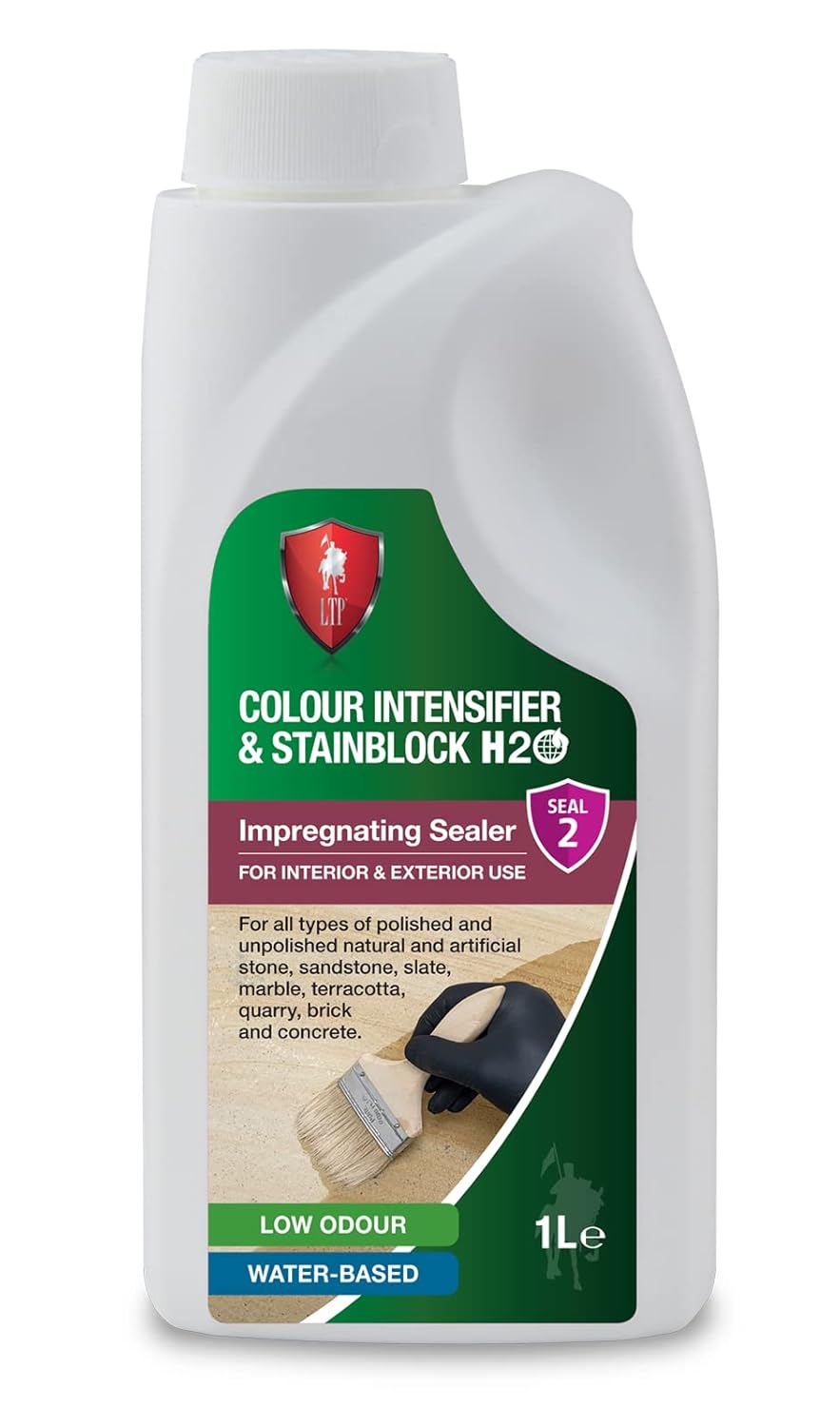
LTP Colour Intensifier & Stainblock H20
|
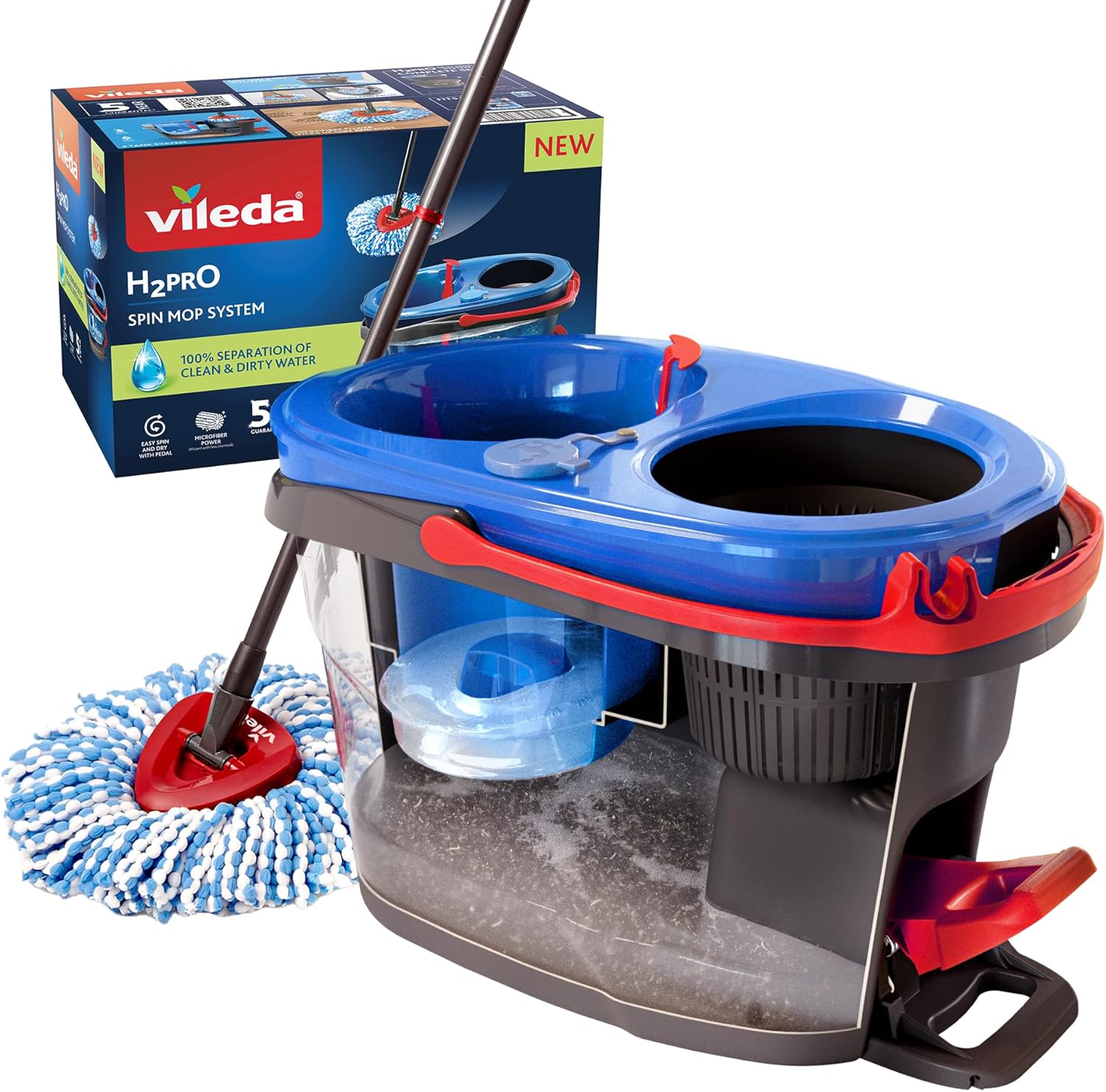
Vileda H2PrO Spin Mop System
|
Over time, however, these tiles often lose their visual impact due to surface wear, chemical reactions, and environmental influences. Restoring their original vibrancy is a specialist task requiring an in-depth understanding of the materials, historically accurate techniques, and premium products to ensure a successful outcome.
Identifying the Key Factors Leading to the Fading and Dulling of Victorian Mosaic Tiles
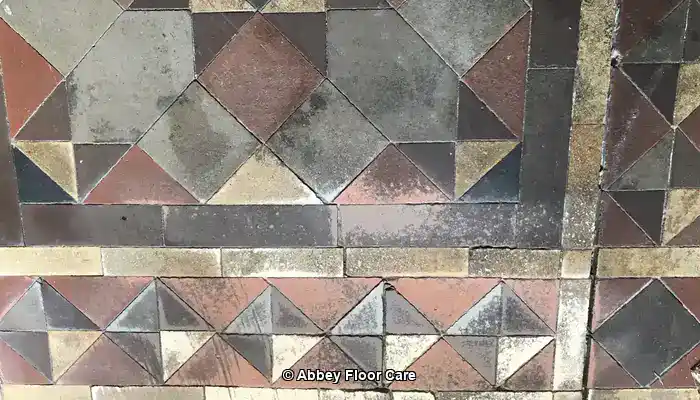
Example of Victorian Clay Tile Floor dulled through surface wear and damage.
Although the pigments are integral to the tile structure, various elements contribute to their fading and dulling over time:
- Accumulated dirt and grime: Continuous foot traffic leaves behind fine particles and oils that penetrate porous surfaces, scattering light and dulling the vibrant colours.
- Wax and polish buildup: Non-breathable layers of wax or sealants trap moisture, resulting in a cloudy or yellowed appearance that obscures the original hues.
- Moisture-related issues: Many Victorian tiles were installed over subfloors lacking damp-proof membranes, leading to rising damp that carries soluble salts. These salts crystallize on tile surfaces as efflorescence, obscuring the original hues.
- Physical abrasion: Years of foot traffic can create small surface scratches that disrupt the smooth reflection of light, diminishing visual richness and overall appeal.
Effective restoration strategies precisely tackle each of these contributors without compromising the historical makeup of the tiles, ensuring a thorough recovery of their original charm and beauty.
Understanding the Importance of Breathability for Tiles Lacking a Damp-Proof Membrane
Many Victorian tiled floors exist on older subfloors that do not include a damp-proof membrane (DPM), making it essential for their natural clay composition to remain permeable. This permeability allows moisture to evaporate from the subfloor effectively. Non-breathable wax coatings or film-forming sealers obstruct this vital evaporation pathway, causing moisture accumulation beneath the surface. This entrapment can lead to salts and humidity being trapped, resulting in efflorescence, degradation of surface minerals, and the condition known as wax blooming—a whitish film or haze on the tile. Restoration strategies must prioritize breathable impregnating sealers that protect tiles while allowing moisture vapour to escape freely, preventing long-term damage and ensuring the integrity of the tiles is maintained.
Gaining Insight into the Composition and Pigments of Victorian Tiles
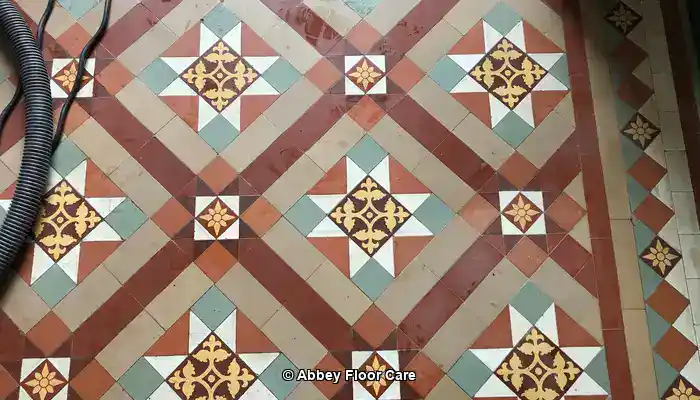
An example of different pigments in a Victorian Clay tile floor during restoration by Abbey Floor Care
Exploring the Mineral Oxide Pigments Utilized in Victorian Tiles
Victorian mosaic and encaustic tiles derive their distinctive earthy hues from mineral oxide pigments embedded directly into the clay. These pigments are fundamental to the tiles’ durability and depth of colour. The primary pigments include:
- Iron oxide: produces terracotta reds, rust browns, and soft ochres that are characteristic of Victorian design.
- Manganese: results in deep browns and rich blacks, adding to the visual complexity of the tiles.
- Cobalt: offers various shades of blue that bring vibrancy and contrast to tile patterns.
- Chromium: yields natural green tones, enhancing the diversity of colour options available in Victorian tiles.
Comprehending the Firing and Fusion Process of Victorian Tiles
During production, the tiles are fired at high temperatures, approximately 1100°C, which vitrifies the clay and fuses the pigments deep into the tile body. This firing process guarantees that the colour permeates the entire tile rather than merely sitting on the surface, providing long-lasting vibrancy and resistance to fading, which is crucial for maintaining the tiles’ aesthetic appeal over time.
Understanding the Porous Unglazed Finish of Victorian Tiles: Key Considerations
Victorian tiles are characterized by a porous, unglazed matte finish that promotes a natural appearance, enhancing their aesthetic value. However, this porosity makes the tiles more absorbent and vulnerable to surface contamination and moisture, necessitating careful cleaning and maintenance to uphold their beauty and structural soundness. Proper care is essential to prevent stains, discoloration, and other issues that can arise from neglecting their unique properties.
Assessing Variability in Colour Durability Across Different Tile Types
Natural earth pigments, particularly in red and yellow tiles, contain fewer mineral additives compared to darker colours like black, which incorporate manganese. Consequently, red and yellow tiles are less durable and more susceptible to surface dishing under heavy foot traffic. This wear manifests as shallow depressions in heavily trafficked areas, resulting in uneven colour intensity and loss of surface flatness over time. Understanding these differences is crucial for effective restoration and maintenance planning.
Critical Considerations for Effective Restoration Planning
Understanding pigment composition and wear patterns of tiles is vital for effective restoration planning. Softer-toned tiles necessitate gentler cleaning and specialized impregnating sealers that respect their physical properties while enhancing colour depth. In contrast, darker, more resilient tiles can endure more intensive cleaning yet still require breathable, colour-enhancing protection to maintain vibrancy and prevent deterioration over time. A tailored approach ensures that each type of tile receives the appropriate care and restoration treatment necessary for longevity.
Implementing Successful Restorative Cleaning Techniques for Victorian Mosaic Tiles
Successfully cleaning Victorian encaustic and mosaic tiles is crucial for returning them to their original vibrancy. However, this task requires a specialized approach that goes beyond the use of basic pH-neutral detergents typically recommended for standard cleaning. Professional restorers utilize specifically formulated alkaline cleaners and mechanical techniques to effectively break down heavy soiling and old residues without compromising the historic fabric of the tiles, ensuring a thorough and impactful cleaning process that reveals the tiles’ true beauty.
Initial Debris Removal: A Crucial Step in the Cleaning Strategy
The cleaning process commences by removing all loose dirt and debris using soft brushes or vacuuming with brush attachments. This preliminary step is essential to prevent scratching the delicate tile surfaces during subsequent cleaning stages, ensuring that the tiles remain intact and undamaged throughout the restoration process. Effective debris removal sets the foundation for a successful cleaning regimen and enhances the overall results of the restoration effort.
The Vital Role of Alkaline Cleaners for Effective Soil Removal
Unlike pH-neutral cleaners, which often lack the chemical strength necessary to effectively combat ingrained fatty acids and organic soils, alkaline cleaners are indispensable for thoroughly breaking down household oils, grease, and sticky residues commonly found on tile surfaces and in grout lines. These alkaline formulations dissolve the binding agents of dirt, sugars, and fats, enabling their effective removal while remaining compatible with the mineral composition of Victorian tiles. Professional-grade alkaline products, such as PS87 PRO or bespoke formulations from heritage cleaning specialists, are typically utilized in diluted forms to ensure deep cleaning without excessive aggression towards the clay body. It is crucial to remember that even with alkaline cleaners, caution is necessary, and spot testing is advised to prevent adverse reactions.
Boosting Cleaning Efficiency through Mechanical Agitation
Mechanical action significantly enhances cleaning efficiency. Low-speed rotary scrubbers equipped with red or sometimes green non-abrasive pads are frequently employed to agitate soils from small pits, tile surfaces, and grout lines. These pads clean thoroughly while protecting the integrity of tile edges and delicate surface details, ensuring that the restoration process enhances rather than detracts from the tiles’ original characteristics. This careful balance is vital for achieving a successful restoration.
Eliminating Waxes and Exotic Sealants for a Pristine Surface
Years of use often lead to the buildup of old waxes and sealants, particularly from DIY attempts using unsuitable products. Water-based cleaners—whether alkaline or mildly acidic—are favored for removing these residues without damaging the tile’s mineral structure. However, stubborn ‘exotic’ or solvent-resistant coatings necessitate targeted solvent-based removers such as Lithofin Wax-Off or LTP Solvex. These solvents effectively soften and emulsify waxes and old sealants but must be handled with care by professionals trained in their safe application and disposal to prevent any damage to the tiles.
The Significance of Thorough Rinsing and Drying Following Cleaning
After chemical cleaning, it is vital to rinse thoroughly to eliminate all cleaning residues. Multiple rinsing sessions with clean water, combined with wet vacuum extraction, guarantee that no detergent or solvent traces remain to interfere with subsequent restoration treatments. Drying time can vary based on environmental conditions such as humidity, surface type, and moisture content. Restoration professionals always utilize moisture meters to verify that the tiles are completely dry before applying any impregnating sealers or protective treatments. This careful approach prevents moisture entrapment, which could otherwise lead to efflorescence, staining, or damage beneath sealed layers, ensuring the integrity of the restoration work is preserved.
The Advantages of Comprehensive Cleaning for Successful Restoration
Thorough cleaning unveils the actual condition of the tiles by removing visual barriers. It exposes areas that may require repair and provides a clean, receptive surface for colour-enhancing impregnators or other restorative products. This meticulous preparation is essential to the success and longevity of Victorian mosaic tile restoration, ensuring that the tiles not only appear vibrant but also maintain their structural integrity for many years to come. Successful restoration hinges on this foundational cleaning process.
Enhancing Colour with Premium Impregnating Sealers for Optimal Results
Restoration experts utilize impregnating colour-enhancing sealers from reputable brands such as LTP and Lithofin, known for their advanced, heritage-approved formulations. Unlike superficial coatings, these sealers:
- Penetrate deeply into tile pores, physically enriching colour by altering light refraction, which enhances the visual appeal.
- Maintain vapour permeability, crucial for moisture escape, particularly in older floors lacking damp-proof membrane layers.
- Offer durable protection against stains and foot traffic without altering the natural texture or gloss of the tiles, ensuring their longevity.
- Applied in multiple light coats, each allowed to penetrate before the next is added to ensure uniformity and optimal results, leading to a visually striking finish.
These sealers effectively address fading by restoring vibrancy while preserving the breathable nature of the historic floor, thereby enhancing their longevity and visual appeal significantly.
Repairing Damaged Tiles and Techniques for Colour Tinting: A Comprehensive Approach
Tiles that exhibit chips, cracks, or missing pieces necessitate careful repair using tinted epoxy or lime-based mortars, colour-matched with natural mineral oxides. Restoration specialists seek out matching replacement tiles from salvage archives to ensure pattern continuity, guaranteeing that repaired areas blend seamlessly with the existing design. Colour tinting involves the selective application of earth-pigment-infused wax or resin mixtures to sensitively merge worn or missing pattern areas while respecting tile breathability and reversibility. This meticulous attention to detail ensures that repairs are not only effective but also visually appealing, maintaining the historical integrity of the floor.
Best Practices for Successful Tinting Techniques
- Utilize small, controlled applications to avoid overwhelming the original tile colour and to maintain the authentic appearance, ensuring a harmonious finish.
- Conduct patch testing on inconspicuous areas before full application to confirm compatibility and desired effects, preventing any unintended visual discrepancies.
- Ensure compatibility with the impregnating sealers applied to the entire surface for a cohesive finish, which is crucial for maintaining the overall aesthetic.
Effective Strategies for Maintaining the Beauty of Restored Victorian Mosaic Floors
Preserving the restored colour and condition of Victorian tiles necessitates ongoing care to ensure they remain in pristine condition:
- Regularly clean with pH-neutral, non-abrasive detergents specifically designed for historic tiles to avoid damage and maintain their appearance.
- Implement preventive measures, such as placing entrance mats to minimize dirt ingress and protect the tile surface from wear and tear.
- Promptly address liquid spills, especially acidic substances like vinegar or wine, to prevent surface etching and staining that can compromise their beauty.
- Reapply breathable impregnating sealers every 3 to 5 years or as wear necessitates to maintain protection and vibrancy, safeguarding against future degradation.
- Monitor floors for signs of efflorescence or moisture ingress, indicative of underlying damp issues, to address potential problems early and prevent costly repairs.
Avoiding Common Pitfalls in Tile Restoration for Achieving Optimal Outcomes
- Steer clear of wax treatments that can obstruct breathability, lead to efflorescence, or cause wax blooming, compromising the tiles’ integrity and appearance.
- Avoid the use of acrylic or polyurethane sealants that can trap moisture and contribute to the degradation of the tile material, leading to long-term damage.
- Limit the use of harsh chemical cleaners, as they can erode clay and pigments, resulting in irreversible damage to the tiles’ surface and structure.
- Never repaint tiles; paint films alter their visual and physical properties and are irreversible, compromising the original charm and authenticity of the tiles.
- Identify and address issues in older subfloors before sealing to prevent future complications that could undermine the restoration efforts.
Highlighting Successful Real-World Restoration Projects as Case Studies
Real-world examples showcase the effective application of these principles:
Case Study: Stunning Restoration of a Victorian Hallway in Sheffield
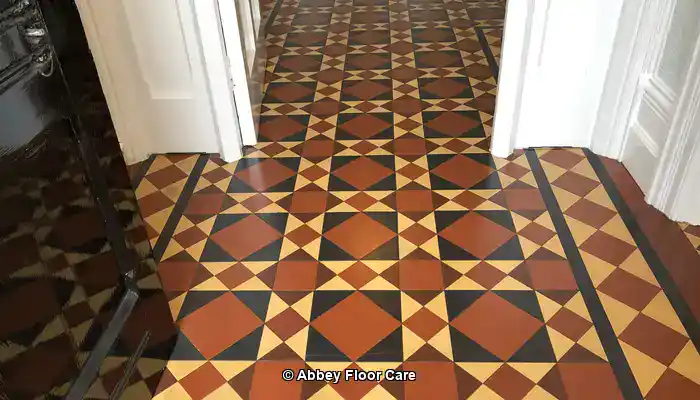
Our comprehensive cleaning process removed years of accumulated wax and grime, followed by the application of Lantania Avo colour-enhancing impregnating sealer, which noticeably deepened the tile colours and restored their vibrancy. This restoration was further enhanced by applying an acrylic topical sealer to provide surface protection on floors installed over a damp-proof membrane, ensuring both aesthetic appeal and durability for generations to come.
Case Study: Reviving a Historic Civic Mosaic Floor in Chesterfield
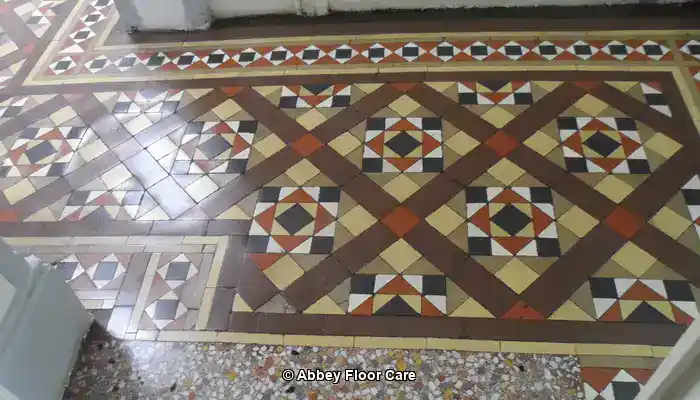
After thorough cleaning and elimination of old topical sealers, the floor was treated with an LTP Colour Enhancing Impregnating sealer. The surface was then further protected with a carefully applied wax, seamlessly integrating the clay tiles into the historic fabric of the building, ensuring that the restoration matched the original aesthetic beautifully while preserving its historical integrity.
Preserving Heritage with Expert Restoration Techniques for Future Generations
Reviving the colour and pigment of Victorian mosaic tiles is a complex endeavor that requires a delicate balance of material science, craftsmanship, and sensitivity to heritage values. The utilization of premium impregnating colour-enhancing sealers from industry leaders such as Dry Treat, Lantania, and Lithofin ensures long-term breathability, protection, and vibrancy. Skilled cleaning, thoughtful repair, and dedicated maintenance uphold authenticity while rejuvenating these historic floors for future generations to appreciate and enjoy their beauty.
Frequently Asked Questions About Restoring Victorian Mosaic Tiles
What defines Victorian mosaic tiles and their unique characteristics?
Victorian mosaic tiles are decorative tiles that gained popularity in the 19th century, celebrated for their vibrant hues and intricate patterns. Often found in public buildings and homes, these tiles showcase the artistry and craftsmanship of their era, contributing significantly to the architectural heritage.
How can I effectively restore faded Victorian mosaic tiles to their original beauty?
Restoring faded Victorian mosaic tiles entails a comprehensive process of cleaning, repairing any damage, applying new pigments to match the original colours, and subsequently sealing the tiles to safeguard against future wear and deterioration. Each step is crucial for maintaining the tiles’ historical and aesthetic value.
What materials are essential for successful tile restoration projects?
Essential materials for tile restoration encompass specialized cleaning solutions, pigments, adhesives, grout, and protective sealants, all meticulously chosen for compatibility with the original tiles to ensure a successful restoration process that honors the historical integrity of the installation.
How long does the tile restoration process typically take to complete?
The time required for tile restoration varies based on the size and condition of the area being restored, typically ranging from a few days for smaller projects to several weeks for larger restorations, influenced by various factors such as the extent of damage and the required techniques.
Is DIY restoration feasible for homeowners?
Yes, smaller restoration projects can be undertaken as DIY if you possess the necessary skills and tools; however, more complex repairs require expert knowledge to ensure quality results and the preservation of the tiles. It’s crucial to assess your capabilities before proceeding with restoration efforts.
What are the estimated costs associated with restoring Victorian mosaic tiles?
Costs for restoration can vary significantly depending on project size and condition, typically ranging from a few hundred to thousands of pounds for comprehensive restorations, based on the extent of work required and the materials used in the process.
How do I choose the right restoration expert for my project?
When selecting restoration professionals, look for those with experience in historical projects, positive reviews, and a commitment to using authentic materials and techniques for the best possible outcome. Ensuring that they understand the unique needs of Victorian tiles is key to successful restoration.
What challenges do restorers commonly encounter during the restoration process?
Restorers often face challenges such as matching original colours, repairing damaged tiles, and ensuring the longevity of the restoration work. Effectively navigating these challenges requires skill, experience, and a deep understanding of the materials and techniques involved.
What maintenance practices should I implement for my restored tiles?
Regular cleaning with pH-neutral products, avoiding harsh chemicals, periodically resealing, and promptly addressing any damage are essential practices for maintaining restored tiles and ensuring their beauty endures over time. These steps are crucial for preserving the investment in your historic flooring.
What innovations are shaping tile restoration practices today?
Recent advancements in tile restoration include cutting-edge cleaning solutions, new types of sealants, and digital technology for precise colour matching and pattern replication. These innovations enhance the quality and efficiency of restoration efforts, making it easier to maintain the integrity of Victorian tiles.
The Article Restoring Colour and Pigment to Faded Victorian Mosaic Tiles first found on https://www.abbeyfloorcare.co.uk
The Article Restoring Colour to Faded Victorian Mosaic Tiles appeared first on https://fabritec.org
The Article Restoring Faded Victorian Mosaic Tiles to Their Original Color Was Found On https://limitsofstrategy.com



No responses yet